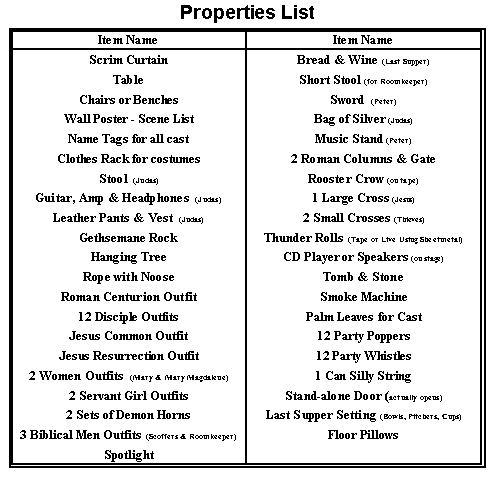 12 Staging
12 Staging
Scrim Curtain: For those of you not familiar with a "Scrim", it is a very sheer white fabric used on stages to separate two areas. When lighting illuminates the area behind the Scrim, the audience can see through Scrim and view the actors as if the Scrim curtain doesn't exist. When the Scrim is illuminated from the front, the sheer white fabric catches the light, making it opaque and hiding everything behind it. A Scrim can be easily and cheaply made with any very sheer fabric or cheesecloth, the "sheerer" the better for viewing the area behind the Scrim with backlighting.
Making a Scrim: To construct a Scrim, the fabric is stretched to eliminate any movement of the fabric by attaching it to a hanging Bar/Pipe on the top and a weighted Bar/Pipe on the bottom. It can also be stretch mounted on a wood frame. The Scrim should not fill the entire width of the stage, but should have wide openings on both ends to allow movement of props and set pieces to the front of the stage.
Scrim Purpose: The purpose of the scrim in our play, is to hide the "drama prop room" when a scene is being acted out downstage. Interesting effects can be easily added, like background projections onto the scrim with a slide projector or overhead projector. Some scenes like Peter in the courtyard could be enhanced with a picture of a courtyard projected from behind onto the scrim. Other scenes like "Gethsemane" could be enhanced with a projection of "stars" onto the screen or Golgotha could be a projection of 3 crosses. The scrim also eliminated the possibility that actors downstage could be upstaged by activity behind the scrim.
Stage Setting: The drama properties room of a Christian church or group. One table surrounded by chairs, a clothes rack on the back wall filled with costumes typical for Christian plays (robes, tunics, Roman soldier outfits, etc), on right, a large Gethsemane Rock, on left, a barren Judas Tree (no noose). Upstage left, a barstool, guitar and guitar stand. The room should be filled with other props appropriate for each song. Also, there should be speakers, CD player, music stands, amplifiers, microphones & stands, etc. The bigger the stage area, the more props there should be to fill up the space. There are no scene changes. Everything that will be used to dramatize each song, should be on-stage and ready to be used. Minimum lighting needs ... a single spotlight. Curtains are not necessary, since transitions from song to song are done with the spotlight and the actors themselves will move props around as needed. When the play is actually being presented, the audience should be ignored like they aren't there. Everyone should exit and enter through the congregation, sanctuary/auditorium as though it were empty.
Play Scenario: The church's drama team has been assigned the task of putting on this year's Easter play. They are meeting to come up with ideas for the play ... music, readings, scripture ... it is a brainstorming session. They are meeting in the drama teams properties room shown above. On the backwall is a large white poster that has been put up by the Drama Leader and will list each scene he wants to develop. On the table are nametags for each character that the Drama Leader wants to highlight in the play (Mary, Centurion, Judas, Peter, etc).
Central Characters: To tie all the various scenes together, each scene should contain a part for at least one of these 3 central characters.
The Drama Leader: He's the guy (or gal) with the leadership capabilities and will direct the sequence of events between each song, reading or scripture. We'll call this person "Leader".
The Props Guy: He's the guy (or gal) that moves the props around on-stage, discovers new things to show the group, or goes off-stage to get stuff. We'll call this person "Props"
The Stage Manager: He's the guy (or gal) that does the special effects, sound, music, everything unrelated to properties. We'll call this person "Manager"
Character List: The following is a list of cast characters. The entire cast is on-stage during the Drama Room scenes. We have noted those who have speaking lines with an "L" and those that participate in songs with an "S". It is worth noting that there are several places where the entire cast helps to sing the Chorus of particular songs.


|



